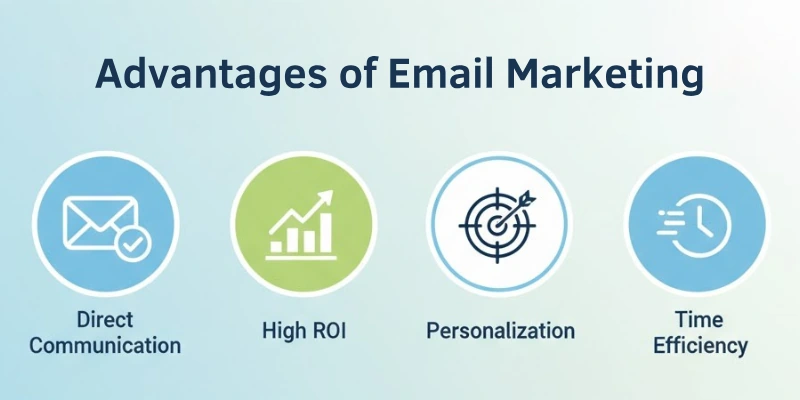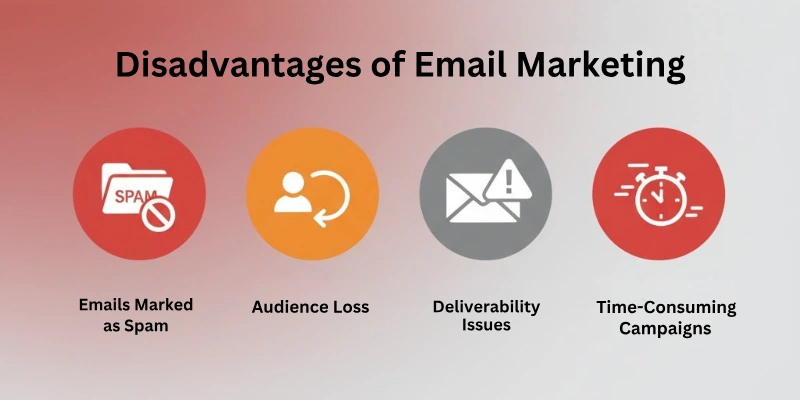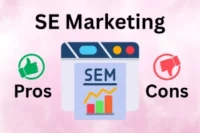Pros and Cons of Email Marketing: Benefits vs Limitations
Published: 13 Oct 2025
Did you know that every day more than 4 billion people around the world use email? With that many people, you have the chance to turn them into loyal customers.
Having a wide reach, however, means having a lot of responsibility. So, guys, this article will explore the advantages and disadvantages of email marketing, helping you decide if it’s the right strategy to achieve your marketing goals or not.
Advantages of Email Marketing
Email marketing offers a wealth of pros for businesses of all sizes. Here’s a quick rundown of some of the key benefits of email marketing that you guys can enjoy:

- High ROI (Return on Investment)
- Targeted Communication
- Cost-Effective
- Builds Relationships
- Increases Brand Awareness
- Scalable
- Measurable Results
- Personalization
- Time-Saving Automation
- Drives Traffic to Your Website
Let’s dig into the all the pros of email marketing in further detail
1. High ROI (Return on Investment)
With email marketing, you get a great return on investment. Email campaigns have a comparatively cheap start-up expense when compared to other marketing platforms. You can turn a significant portion of your email list into paying clients with focused marketing and interesting content.
2. Targeted Communication
Email marketing lets you send specific messages to groups of subscribers. You can personalize emails based on demographics, interests, and purchase history. This laser-focused method makes sure that your message gets through to the right people, which increases the chances of conversions.
3. Cost-Effective
One of the cheapest ways to sell your business is through email marketing. Traditional forms of promotion are much more expensive than building an email list and sending campaigns. You can reach a lot of people and reach your business goals even if you don’t have a lot of money.
4. Builds Relationships
Email marketing is a great way to build relationships with your users that last. By giving your viewers useful content, you become a thought leader and earn their trust. Emailing your customers on a regular basis keeps your company in their minds and makes them more likely to stick with you.
5. Increases Brand Awareness
Brand recognition grows a lot when email marketing is done regularly. Emailing your subscribers exposes your business every time. Creating interesting content and using your brand’s elements in the design can help people recognize your business and give it a strong position in the market.
6. Scalable
If your business grows, email marketing can easily adapt to fit. There aren’t many extra costs that you need to pay in order to grow your email list and keep track of all of your subscribers. Because of this, it’s a great way for businesses of all kinds to market themselves, from small start-ups to big international companies.
7. Measurable Results
Email marketing is different from some other types of marketing because it gives you a lot of information about how your plan is doing. You can find out what your audience likes by looking at read rates, click-through rates, and conversion rates. You can improve your strategy for better results with these measurable results.
8. Personalization
When you use email marketing, personalization is a powerful tool. Using information about your subscribers, you can send them emails with greetings, product suggestions, and material that is relevant to their interests. Using personalized language in your emails makes them more interesting and raises the chances of people buying something.
9. Time-Saving Automation
There are powerful automation tools in email marketing systems that can save you a lot of time and work. By setting up automated email sequences based on user behavior or triggers, you can make sure that messages get sent on time without having to constantly check in and send them.
10. Drives Traffic to Your Website
When done correctly, email marketing can drive a significant number of people to your website. If you include strong calls to action and relevant links in your emails, it’s quite possible that many people will visit your website, look at your goods or services, and eventually buy something.
Disadvantages of Email Marketing
Although email marketing has many benefits, it’s important to be aware of the challenges that could arise. So guys, consider these major cons of email marketing campaign before starting:

- Spam Filters and Deliverability Issues
- Competition in Inboxes
- List Building and Management
- Engagement and Unsubscribes
- Design Responsiveness
- Limited Interactivity
Let’s learn all the limitations of email marketing in detail.
1. Spam Filters and Deliverability Issues
Many spam filters make it hard for your emails to reach your users’ inboxes. This is one of the hardest parts of email marketing. Spam filters can stop emails from getting delivered if they have too much advertising content, spammy subject lines, or content that isn’t related to the subject line. This can make your campaign less successful overall and make it less likely to reach other people.
2. Competition in Inboxes
Every day, people get a lot of emails, ranging from personal messages to sales pitches. In this busy area, it can be hard to stand out. To get people to open your emails, create interesting images, use clear subject lines, and include helpful information.
3. List Building and Management
An effective email list takes ongoing work to build and keep up. Make sure that people who sign up for your newsletter have a real interest in your brand by using sign-up forms and lead buttons. To keep your deliverability rates high and your sender image good, you should also keep your list clean by getting rid of subscribers who aren’t clicking on your emails—quite a tough task!
4. Engagement and Unsubscribes
Sending irrelevant or low-quality emails might result in unsubscribes and decreased overall engagement. So, creating compelling content, personalizing your communications, and providing important information are essential for keeping your audience engaged. And this task is not as easy to take over.
5. Design Responsiveness
With the rising use of mobile devices to check emails, it is critical that your email design be flexible to different screen sizes. Poorly prepared emails that do not display well on mobile devices can annoy subscribers and harm your brand image.
6. Limited Interactivity
Emails, as opposed to other marketing channels, have minimal involvement. While you can add links and calls to action in your emails, real-time engagement is still limited. This can be a drawback when contrasted to social media sites that promote more active connections.
So, Is Email Marketing Right for You?
Here are some recommendations to help you decide:
- Consider your audience: Does your target audience use email regularly?
- Evaluate your resources: Do you have the time and manpower to manage an email list and create engaging content?
- Start small and scale gradually: Build your email list organically and experiment with different strategies to find what resonates with your audience.
Remember: Email marketing, when done correctly, can be a highly successful approach to engage with your audience and achieve your marketing objectives. You can use email marketing to develop long-term client relationships and expand your organization if you understand the benefits and drawbacks and follow best practices.
Conclusion
In this article we have covered all the advantages and disadvantages of email marketing in detail. We have learned how email marketing is helpful for businesses to target their audiences with their products and services directly. And we have also seen how difficult it is to manage this type of digital marketing.
However, it’s important to acknowledge the challenges involved. Competition in inboxes, maintaining high deliverability rates, and keeping subscribers engaged require ongoing effort and strategic planning.
FAQs
Most commonly asked questions related to the advantages and disadvantages of email marketing:
Gary Thuerk, a marketing manager at Digital Equipment Corp., launched the first email marketing campaign in 1978 with 400 users. The email pushed DEC machines, resulting in $13 million in sales. Thuerk is known as the “Father of Spam”.
The digital marketing landscape is vast, but some common types include social media marketing, search engine optimization (SEO), content marketing, pay-per-click (PPC) advertising, and email marketing.
Here are those:
- Advantages: cost-effective, targeted reach, measurable results, builds relationships, scalable.
- Disadvantages: Competition in inboxes, spam filters, requires list building and management.
Here we go:
- Advantages: efficient communication, document sharing, and global reach.
- Disadvantages: information overload, misinterpretation, and the potential for security breaches.
While not all are exclusive to email, some key advantages include reaching a large audience, fast and convenient communication, allowing for targeted messaging, cost-effectiveness, measurable results, personalization, and storing communication history.
The primary disadvantage of email is competition in inboxes. With so many emails vying for attention, it can be challenging to get your messages seen and acted upon.

- Be Respectful
- Stay Relevant
- Stay Positive
- True Feedback
- Encourage Discussion
- Avoid Spamming
- No Fake News
- Don't Copy-Paste
- No Personal Attacks

- Be Respectful
- Stay Relevant
- Stay Positive
- True Feedback
- Encourage Discussion
- Avoid Spamming
- No Fake News
- Don't Copy-Paste
- No Personal Attacks





